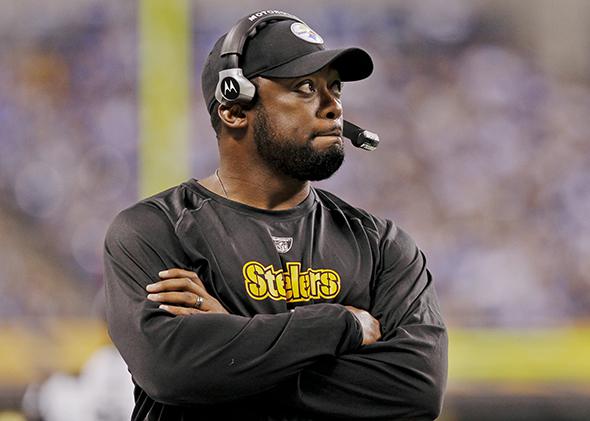Two months ago, Pittsburgh Steelers coach Mike Tomlin stepped onto the field during a kickoff return, blocking the path of the Baltimore Ravens’ Jacoby Jones. No flag was thrown, but Tomlin was later hit with a $100,000 fine from the NFL. Though Tomlin apologized, he also defended himself from accusations that his actions were intentional, saying, “If anybody thinks I or anybody else would do this on purpose, they are crazy.”
Though Tomlin’s intent on the play was very difficult to judge, an NFL official told me that the coach was fined because of the perception that he’d inched into the action purposefully. While it’s tough to say whether that’s the really case, when you watch the play in slow motion it does start to look like the Steelers coach knew what he was doing.
In the Super Bowl, every key play will be poked and prodded, often in slow motion. When we look at these big moments, we’ll try to get inside each participant’s helmet and ask: What was he thinking? If some new research is to be believed, these super-slo-mo replays will give us the wrong idea. When we slow things down, accidents start to look intentional.
Zach Burns, a psychologist at Northwestern University’s Kellogg School of Management, believes that in sports—and in law—we should not watch slow-motion footage when we’re trying to gauge intent. In one of Burns’ studies, which he completed for his dissertation at the University of Chicago’s Booth School of Business, in collaboration with Eugene Caruso, subjects watched three different clips, either at normal speed or at about one-third speed. One clip showed a boxer punching below the belt while another depicted a basketball player elbowing another in the face. The third showed the helmet-to-helmet collision between the Steelers’ James Harrison and the Cleveland Browns’ Mohamed Massaquoi in 2010, knocking him out of the game with a concussion. (Harrison wasn’t penalized but was later fined $75,000 for the hit.)
Slowed down, the acts were judged as more intentional, forceful, blameworthy, and deserving of punishment than they were at normal speed. When viewed at regular speed, there’s some question about whether Harrison smashed Massaquoi in the head on purpose; when the video gets slowed down, it seems as if the Steelers defender is preparing himself to deliver a crushing blow. Indeed, another of Burns’ experiments, using footage of a man on a bicycle who hits a target with a foam sword, found that when we watch something in slow motion, we perceive an increase in the amount of time the person—whether a football player or a cyclist with a sword—had to prepare for the act.
Maybe in all these cases the act really was intentional, and slow motion merely helped viewers see the truth by picking up on subtle behavioral cues. After all, Harrison has stated that he aims to hurt other players, and Massaquoi was the second Cleveland player he knocked out with a concussion in the second quarter of a single game.
In additional experiments, Burns found that slow motion does not in fact reveal the truth. It also doesn’t always lead you to believe that a person’s behavior was premeditated. Rather, it amplifies your incoming assumptions: If you think an act was intentional, seeing it in slow motion increases the apparent intentionality, and if you think it wasn’t intentional, slow motion decreases apparent intentionality. Burns does believe, though, that if you’re on the fence—and the point of instant replay is to scrutinize calls that are too close to discern in real time—slow motion will push you to see intentionality. Previous research has shown that we already see intentionality in people’s behaviors by default. Evelyn Rosset, for instance, found that our instinct is to judge sentences such as “She kicked her dog” as describing acts done with purpose.
Across various sports leagues, fines and penalties are levied by referees and league pooh-bahs who watch slow-motion replays to judge intent. Though helmet-to-helmet hits are penalized in the NFL even if they’re accidental, a particularly malicious-looking strike will draw a larger fine. Burns also points out that NBA referees review flagrant fouls using slow-motion replay, labeling them as “flagrant 1” or the more serious “flagrant 2,” which leads to an immediate ejection. Slowed-down replays likely heighten players’ perceived intent, leading to more disqualifications.
The effect of slow motion has implications outside sports. In 2007, a man named John “Jordan” Lewis shot and killed a police officer while robbing a Dunkin’ Donuts. The jury convicted him of first-degree murder—premeditated killing. His attorneys had pushed for a judgment of second-degree murder, arguing that Lewis had panicked. They appealed to the Pennsylvania Supreme Court, saying that playing the surveillance tape in slow motion had biased the jury. The higher court affirmed the sentence last May, noting that the jury was reminded that the events depicted happened faster in real life. It’s unclear if this kind of warning would be enough to overcome the way we think once we see something in slow motion.
“The real-world advice I have is to never try to assess intent with slow motion,” Northwestern’s Burns says. “And stronger still, if you are assessing intent, never see the slow-motion version, ever,” due to the lingering effect a slowed-down clip can have on your perceptions. Burns suggests that sports leagues and courts get away from judging intent altogether in many cases. “If it’s only based on the actions themselves”—whether someone crossed a line, say—“then by all means, slow motion away.” At all other times, we should slow down at our own peril.
